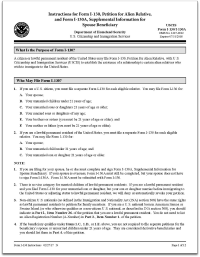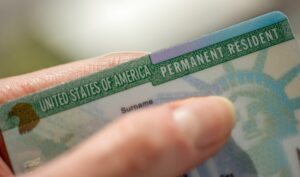
Although step-by-step guides through Form I-130, Petition for Alien Relative, can be helpful, they rarely cover the important or difficult topics. You can find the official set of I-130 instructions on the USCIS.gov website. But this overview introduces some of the broader — and critically important — issues you won’t find in the I-130 instructions. Everybody’s case is unique – there is no simple set of filing instructions for Form I-130.
The relationship between the petitioner and the beneficiary (intending immigrant) affects the instructions. Likewise, other factors such as adoption, step relationships, previous marriages, and immigration history also have an impact on supporting documentation.
Before you blindly fill out an I-130 petition, get to know these issues and how they can affect your relative’s immigration case.
Part 1. Relationship
First, you must select the type of relative that you want to petition. While U.S. citizens may sponsor any of the options (spouse, parent, brother/sister, or child), lawful permanent residents may only petition a spouse or unmarried child. If this is unfamiliar to you, visit our overview on the basic rules of family-based immigration.
If you are filing the I-130 petition for a child or parent, you’ll need to select an option for the type of relationship: biological, stepchild/stepparent, or adoptive. Cases with biological relationships are generally the most straightforward, but the laws that affect step relationships and adoptive relationships get more complicated. For example, the marriage that created a stepchild/stepparent relationship must take place before the child’s 18th birthday. Petitioners with step or adoptive relationships will also have to submit additional documentation as evidence of the relationship.

There are some additional questions about adoptive relationships. The questions are generally easy to answer. However, as previously explained, adoptive relationships can make the visa petition process more complicated and the use of an immigration attorney is generally recommended.
Part 2. Information About You (Petitioner)
Most of Part 2 is easy to understand, but there are a few key concepts that the preparer should be aware of that are not covered in the USCIS I-130 instructions.
Address History
For U.S. citizens, the country where you live is not a major issue as it relates to the I-130 petition. However, your country of domicile will have a significant affect on your overall case. After the I-130 is approved and your relative applies for a green card, the petitioner will have to prepare Form I-864, Affidavit of Support. The petitioner (sponsor) must be domiciled in the United States to file Form I-864, Affidavit of Support. Generally, there are three possible scenarios:
- If the sponsor lives and works in the United States, the country of domicile is the United States. There is no issue.
- If the sponsor lives outside the United States due to temporary employment but has maintained a home in the U.S. and intends to return to that home, the country of domicile is the United States.
- If the sponsor lives permanently outside the United States, there may be a problem. The sponsor must supply evidence (with Form I-864) that he or she will reestablish domicile in the United States.
RECOMMENDED: Proof of Domicile on I-864 Affidavit of Support
A lawful permanent resident may have a more significant issue if he or she is “living” outside the United States. Stays in foreign countries as little as 180 days can lead to green card abandonment.
Your Marital Information
If the beneficiary of your petition is a spouse, expect your marital history (if applicable) to get extra attention. For starters, you’ll need to prove that any previous marriages (for you or your spouse) have ended. In other words, you’ll need a divorce decree, annulment or death certificate.
If you gained your lawful permanent resident status by virtue of a prior marriage to a U.S. citizen or lawful permanent resident, you may not file Form I-130 for a spouse unless:
- A period of 5 years has elapsed since you became a lawful permanent resident; or
- Your prior marriage through which you gained your permanent residence was terminated by death of your former spouse.
If you cannot meet one of the above criteria, a third option exists. There is an exception if you can establish by clear and convincing evidence that the prior marriage through which you gained your permanent residence was not entered into for the purpose of evading any provision of the immigration laws. This can be difficult and may require the assistance of a legal expert.
Part 3. Biographic Information
As you may have noticed, Hispanic/Latino is provided as a choice for ethnicity, but it is not provided as a choice for race. This is because USCIS (and the U.S. government) do not define Hispanic/Latino as a race.
For race, you must choose one or more of the values provided in the list. There is no wrong answer. You may answer the question with the race(s) you most closely identify.
Applicants from Cuba, Mexico, Puerto Rico, South or Central America, or any other Spanish culture or origin should choose the race(s) that fits best for your situation. Many Hispanic petitioners select “white” but others choose “black” or “American Indian.” (You may choose more than one.) There is no one single answer that works for all Hispanic people. The answer is individual to you.
Part 4. Information About Beneficiary (the intending relative)
Again, most of the information that’s required per the Form I-130 instructions is straightforward. But the I-130 instructions don’t necessarily reveal the reasons some of this information is necessary.
Beneficiary’s Marital Information
As previously mentioned, visa petitions for spouses will get some extra scrutiny. This is especially true if there’s a history of marriage fraud. If it has ever been legally determined that your spouse attempted or conspired to enter into a marriage for the purpose of evading U.S. immigration laws, your petition will receive extreme scrutiny. If this situation applies to you and your spouse, contact an immigration attorney before filing Form I-130.
Information About Beneficiary’s Family
You have the opportunity to list the beneficiary’s spouse and children. “Children” includes only unmarried children under age 21 (if applicable). Include all children even if they will not be immigrating to the United States.
If the spouse and children also intend to immigrate to the United States, it may or may not be necessary to file separate I-130 petitions. This can be confusing for many petitioners. You are not required to file separate petitions for the beneficiary’s spouse or unmarried children (under 21) if the beneficiary is your:
- Married son or daughter and you are a U.S. citizen
- Brother or sister and you are a U.S. citizen
- Spouse and you are a lawful permanent resident
- Unmarried child (under 21) and you are a lawful permanent resident
- Unmarried son or daughter (21 or older) and you are a U.S. citizen or lawful permanent resident
The spouse and children in these cases (as listed above) qualify as “derivative beneficiaries.” A separate I-130 is not required. Once the I-130 is approved and current, the derivative beneficiaries may apply for an immigrant visa (green card) at the same time as the principal beneficiary.
This is not the case for the spouse and children of immediate relatives. For example, if you are a U.S. citizen petitioning a spouse, you must file separate I-130 petitions for your spouse’s unmarried children under 21 years of age. This is one of the most overlooked details in the I-130 instructions.
Beneficiary’s Entry Information
If your relative has ever been in the United States, this is an extremely important section. Generally anyone with a period of unauthorized stay (through unlawful entry or visa overstay) should seek the advice of an immigration attorney.
Unauthorized Stay
When a foreign national remains in the United States longer than the period of authorized stay, it’s called “overstaying” a visa.

Your relative’s visa may be valid for several years. However, the visa does not govern the length of his or her authorized stay in the U.S. — it merely allows your relative to enter the United States during that time period. Instead, your relative’s Form I-94 governs your relative’s authorized stay in the United States. The date on your relative’s Form I-94 is the last day he or she is permitted to remain in the U.S., and it may not be valid for as long as the visa is valid. Your relative must depart the U.S. by the date on the Form I-94, or he/she will have overstayed the visa.
Overstaying a visa can have significant, long-term consequences. If your relative overstays a visa for 180 days or more (but less than one year), when he/she departs the U.S. he/she will be barred from reentering the U.S. for three years. If your relative overstays a visa for one year or more, when he/she departs the U.S. he/she will be barred from reentering the U.S. for 10 years. Bars to reentry will severely damage your relative’s attempts to obtain a green card.
Generally, an immediate relative may adjust status (file I-130 and I-485 concurrently) if the overstay is less than 180 days. Any family preference type relationship should leave the U.S. as soon as possible and/or contact an experienced immigration lawyer. The immigrant is deportable during any period after the last day of authorized stay and before he/she becomes an adjustment of status applicant.
RECOMMENDED: Applying for a Green Card After a Visa Overstay
Unlawful Entry
If your relative is planning to adjust status to permanent resident, the immigration status (class of admission) is very relevant. For starters, your relative must have a lawful entry to adjust status. The I-130 instructions do not cover this topic. That’s because the lawful entry is a requirement for Form I-485. But you are documenting your relative’s immigration history. If there are discrepancies or past violations, they’re on record.
Lawful entry means that your relative was admitted or paroled into the United States. In most cases, this means that the visitor entered the United States with valid documentation and made face to face contact with a U.S. immigration officer and that officer acknowledged entry to the United States. Typically, this happens at a port of entry (airports, seaports, etc.) when the visitor shares his or her passport and visa. However, at some border entries, visitors may be “waved” across while in their cars. This also counts as a lawful entry as long as the visitor had the proper documentation (e.g. Visa Waiver Program). If the visitor entered with a valid visa, but that visa has since expired, the visitor still had a lawful entry.
Part 5. Other Information
The petition asks if you ever previously filed a petition for this beneficiary or any other alien (relative). If you have submitted previous petitions, consider what happened and review the previous petitions you’ve submitted. You need to be certain that your facts are consistent. This is especially true if you’ve filed Form I-130, and USCIS denied the petition. Understand the reasons for the denial, how it may impact your current petition, and consult with an immigration attorney if necessary.
How CitizenPath Makes I-130 Instructions Easier

CitizenPath.com can help you prepare Form I-130, Petition for Alien Relative, to navigate through these issues. Immigration attorneys designed the affordable service to include simple I-130 instructions. CitizenPath will provide an instant warning if your answer to a question could be problematic. We’ll also make certain that your petition is complete. In fact, we guarantee that USCIS will approve your I-130 petition.
What’s more, the service includes a set of simple I-130 instructions for filing the petition. CitizenPath customizes the filing instructions based on the petitioner’s unique situation. So you will know exactly which documents to submit with the petition and where to mail it.
CitizenPath’s online service is even free to try. If you’re not eligible or if we find a problem, you can stop at any time. No payment is required until you reach the end of the petition. Try it now.
Note to Reader: This post was originally published on May 23, 2017, and has been modified with improvements.
Want more immigration tips and how-to information for your family?
Sign up for CitizenPath’s FREE immigration newsletter and
SAVE 10%
on our immigration services




